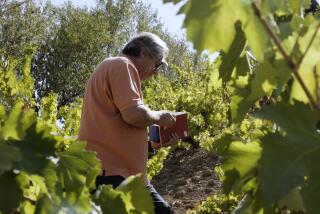Czar’s Vintages Can’t Command Imperial Bids
- Share via
LONDON — Nestled in cellars tunneled deep into a Crimean mountainside, they survived revolution, war and decades of communism.
Hundreds of bottles of wine selected for the pleasure of Czar Nicholas II and preserved on the orders of Josef Stalin were auctioned by Sotheby’s in London on Friday -- the latest in a slew of Russian collectibles being snapped up at ever-rising prices.
Several dozen Russian and European collectors gathered at Sotheby’s to bid on bottles, some more than 150 years old and valued at several thousand dollars, from the imperial Massandra winery near Yalta on Ukraine’s Black Sea coast.
“I think you’ll find some very serious people here,” said Nick Stevenson, an insurance broker hoping to add to a personal wine collection he valued at about $15,000. “Compared to some of the people here, I’m an amateur.”
This is Sotheby’s fourth sale of wines from Massandra since 1990. Money has been used for investment in the winery, which is still in operation.
London has earned the nickname “Moscow on Thames” for its growing community of wealthy Russians, including billionaire tycoon Roman Abramovich, owner of Chelsea soccer club, and self-exiled business mogul Boris Berezovsky.
Art experts say Russian buyers are using their increasing economic muscle to reclaim their cultural heritage, and two recent London auctions of Russian art attracted huge interest and hefty prices.
Sales at Christie’s on Tuesday and Sotheby’s on Wednesday both drew bids totaling more than $17 million.
Ivan Aivazovskii’s snowy St. Petersburg scene “St. Isaac’s on a Frosty Day” sold to an anonymous buyer at Christie’s for $2.1 million, a record for a 19th century Russian work at auction. Almost a third of the buyers at the Christie’s sale were from Russia.
Joanna Vickery, head of Sotheby’s Russian department, said the sales showed that “Russian clients are continuing to dominate this market. Whilst they are becoming more selective about what they buy, they are willing to pay large amounts for top-quality works of art.”
They may be becoming more selective about fine wines too.
Despite high levels of interest in the Sotheby’s sale, almost two-thirds of the 522 lots did not reach their reserve prices. Of those that sold, the most expensive -- a 1913 Kron Brothers Sercial-Verdelho-Albillo from the czar’s collection -- went for $8,000. Some lots consisted of only one bottle, while others contained up to six.
Some of the rarest and most expensive wines did not sell, including four of the five bottles of 1880 “Seventh Heaven,” a rich, sweet wine produced by Massandra’s first wine master, Prince Lev Golitzin, and valued at up to $2,800 each.
The Massandra winery was built in the 1890s to supply Nicholas II’s nearby summer palace. Bottles of wine, some dating from the 18th century, were stored in tunnels, some 500 feet long, dug into a mountainside.
The tunnels provided perfect storage conditions for a collection, now estimated at almost 1 million bottles, that combines vintages from around the world with locally produced sweet and fortified wines such as Madeiras, muscats and ports.
In the upheaval spawned by the 1917 Bolshevik revolution, the tunnels were bricked up to preserve the collection. It was discovered in 1920 when the Red Army took over the Crimea.
Remarkably, the Soviet leaders kept the collection intact. In 1922, Stalin, reportedly impressed by the wines he had sampled, ordered that any wine found in the czar’s cellars throughout Russia be taken to Massandra for storage.
“The fact they are still around is remarkable, because presumably Stalin had access to these wines and he did not go through the whole lot,” said Stephen Mould, a director of Sotheby’s wine department. “And the fact that pre-1917, these wines were being made for the czar gives them a special quality.”
Having survived the revolution, the collection was menaced during World War II by the threat of a Nazi invasion. In 1941, the bottles were labeled and removed to secret locations. In 1945, they were painstakingly moved back.
“The only wine they didn’t take was the 1941 vintage, which was still in vats,” Mould said. “They tipped it into the Black Sea.”
Mould, who tasted some of the wines being auctioned, said their state of preservation, thanks to their high sugar content, is “astonishing,” and their rich, complex flavor unique.
Mould raved about an 1888 Massandra Pinot Gris, a bargain at $3,600-4,600 for two bottles, that he described approvingly as “like cake mixture -- this amazing flavor of the sweetness and the vanilla. I was almost taken back to my childhood.”
Despite his enthusiasm, it didn’t sell.
More to Read
Sign up for Essential California
The most important California stories and recommendations in your inbox every morning.
You may occasionally receive promotional content from the Los Angeles Times.













